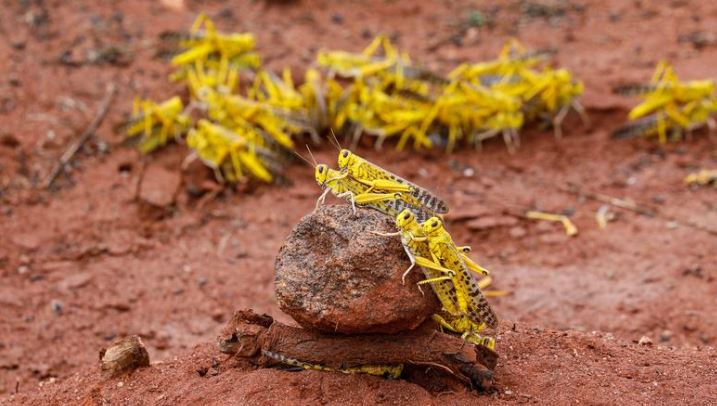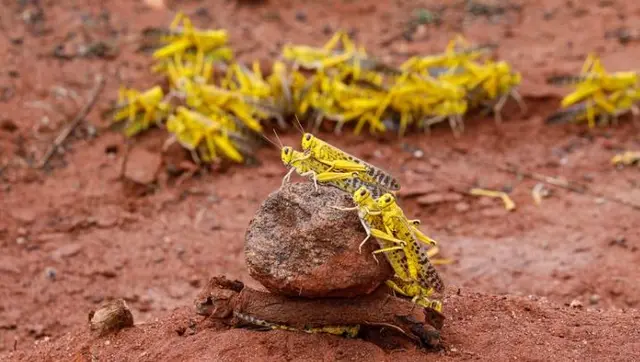
Locusts are seen as they copulate in the region of Kyuso, Kenya, February 18, 2020. The swarms, first sighted in December, have already destroyed tens of thousands of acres of farmland in Kenya, Somalia and Ethiopia./Reuters
Countries in East Africa are racing against time to stop new swarms of locusts from wreaking havoc with crops and livelihoods after the worst infestation in generations.
A lack of expertise in controlling the pests is not the only problem. Kenya temporarily ran out of pesticides, Ethiopia needs more planes and Somalia and Yemen, torn by civil war, can't guarantee exterminators' safety.
Locust swarms have been recorded in the region since biblical times, but unusual weather patterns exacerbated by climate change have created ideal conditions for insect numbers to surge, scientists say.
Warmer seas are creating more rain, wakening dormant eggs, and cyclones that disperse the swarms are getting stronger and more frequent.
In Ethiopia, the locusts have reached the fertile Rift Valley farmland and stripped grazing grounds in Kenya and Somalia. Swarms can travel up to 150 km (93 miles) a day and contain between 40-80 million locusts per square kilometer.
If left unchecked, the number of locusts in East Africa could explode 400-fold by June. That would devastate harvests in a region with more than 19 million hungry people, the U.N. Food and Agriculture Organization (FAO) has warned.
Uganda has deployed the military. Kenya has trained hundreds of youth cadets to spray. Lacking pesticides, some security forces in Somalia have shot anti-aircraft guns at swarms darkening the skies.
Everyone is racing the rains expected in March: the next generation of larvae is already wriggling from the ground, just as farmers plant their seeds.
"The second wave is coming," said Cyril Ferrand, FAO's head of resilience for Eastern Africa. "As crops are planted, locusts will eat everything."
The impact so far on agriculture, which generates about a third of East Africa's economic output, is unknown, but FAO is using satellite images to assess the damage, he said.
PESTICIDE SHORTAGES
In Kenya, the region's wealthiest and most stable country, the locusts are mostly in the semi-arid north, although some crops have been affected, said Stanley Kipkoech, a senior official at the Ministry of Agriculture.
This month, Kenya ran out of pesticide for about a week and a half, he said. Farmers watched helplessly as their families' crops were devoured.
In Ethiopia, the government can only afford to rent four planes for aerial spraying, but it needs at least twice that number to contain the outbreak before harvesting begins in March, Zebdewos Salato, director of plant protection at the Ministry of Agriculture, told Reuters.
"We are running out of time," he said.
Ethiopia's single pesticide factory is working flat out.The country needs 500,000 liters for the upcoming harvest and planting season but is struggling to produce its maximum 200,000 liters after foreign exchange shortages delayed the purchase of chemicals, the factory's chief executive Simeneh Altaye said.
FAO is helping the government to procure planes, vehicles and sprayers, said Fatouma Seid, the agency's representative in Ethiopia. It is also urgently trying to buy pesticides from Europe.
Source(s): Reuters
 简体中文
简体中文

